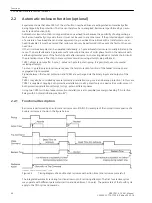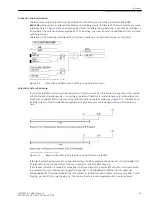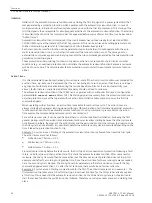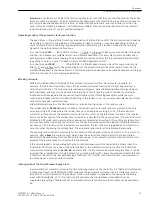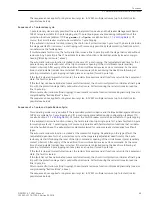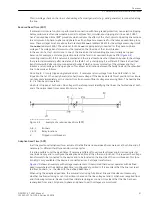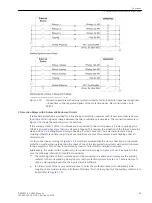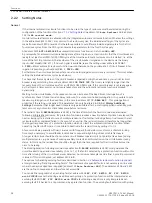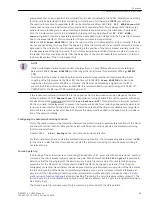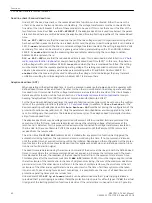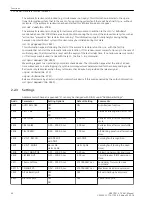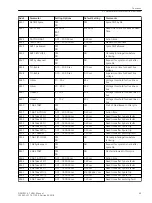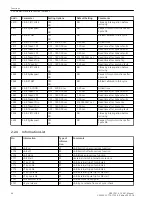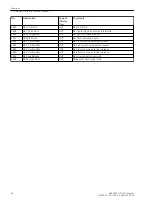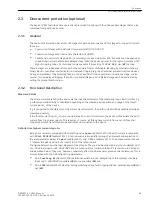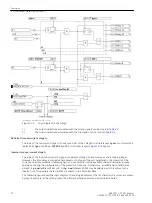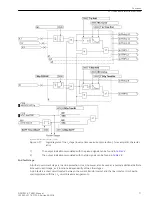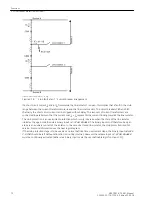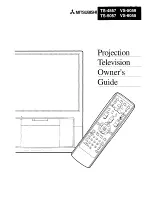
Setting Notes
General
If the internal automatic reclosure function is to be used, the type of reclosure must be selected during the
configuration of the functions (Section
Auto Reclose
and in address
134 the
AR control mode
.
Up to 8 reclosure attempts are allowed with the integrated automatic reclosure function. Whereas the settings
in the addresses 3401 to 3441 are common to all reclosure cycles, the individual settings of the cycles are
made from address 3450 onwards. It is therefore possible to set different individual parameters for the first
four reclose cycles. From the fifth cycle onwards the parameters for the fourth cycle apply.
At address 3401
AUTO RECLOSE
the automatic reclosure function can be turned
ON
or
OFF
.
A prerequisite for automatic reclosure taking place after a trip due to a short-circuit is that the circuit breaker is
ready for at least one OPEN-CLOSE-OPEN cycle at the time the automatic reclosure circuit is started, i.e. at the
time of the first trip command. The readiness of the circuit breaker is signaled to the device via the binary
input
>CB1 Ready
(No. 371). If no such signal is available, leave the setting under address 3402
CB?
1.TRIP
=
NO
, as automatic reclosure function would otherwise not be possible at all. If circuit breaker inter-
rogation is possible, you should set
CB? 1.TRIP
=
YES
.
Furthermore, the circuit breaker ready state can also be interrogated prior to every reclosure. This is set when
setting the individual reclose cycles (see below).
To check that the ready status of the circuit breaker is regained during the dead times, you can set a circuit
breaker ready monitoring time under address 3409
CB TIME OUT
. The time is set slightly longer than the
recovery time of the circuit breaker after an OPEN-CLOSE-OPEN cycle. If the circuit breaker is not ready again
by the time this timer expires, no reclosure takes place and the automatic reclosure function is blocked
dynamically.
Waiting for the circuit breaker to be ready can cause an increase of the dead times. Interrogation of a
synchronism check (if used) can also delay reclosure. To avoid uncontrolled prolongation, it is possible to set a
maximum prolongation of the dead time in this case in address 3411
T-DEAD EXT.
. This prolongation is
unlimited if the setting ∞ is applied. This parameter can only be altered in DIGSI at Display Additional
Settings. Remember that longer dead times are only permissible after 3-pole tripping when no stability prob-
lems occur or a synchronism check takes place before reclosure.
The restraint time
T-RECLAIM
(address 3403) is the time after which the fault is considered eliminated
following erfolgreichenreclosure. If a protection function provokes a new trip before this time has elapsed, the
next reclosing cycle is started in case of multiple reclosure. If no further reclosing attempt is allowed, the last
reclosure will be considered failed in the event of a new trip. The reclaim time must therefore be longer than
the longest response time of a protection function which can start the automatic reclosure function. When
operating the AR in ADT mode, it is possible to deactivate the reclaim time by setting it to 0 s.
A few seconds are generally sufficient. In areas with frequent thunderstorms or storms, a shorter blocking
time may be necessary to avoid feeder lockout due to sequential lightning strikes or cable flashovers.
A longer reclaim time should be chosen where circuit breaker supervision is not possible (see above) during
multiple reclosures, e.g. because of missing auxiliary contacts and information on the circuit breaker ready
status. In this case, the reclaim time should be longer than the time required for the circuit breaker mecha-
nism to be ready.
The blocking duration following manual close detection
T-BLOCK MC
(address 3404) must guarantee the
circuit breaker to open and close reliably (0.5 s to 1 s). If a fault is detected by a protection function within this
time after closing of the circuit breaker was detected, no reclosure takes place and a final 3-pole trip command
is issued. If this is not desired, set address 3404 to 0.
The options for handling evolving faults are described in Section
2.2 Automatic reclosure function (optional)
at margin heading “Handling evolving faults”. The treatment of sequential faults is not necessary on line ends
where the adaptive dead time is applied (address 133
Auto Reclose
=
ADT
). The addresses 3406 and 3407
are then of no consequence and therefore not accessible.
You can define recognition of an evolving fault at address 3406
EV. FLT. RECOG.
.
EV. FLT. RECOG.
with PICKUP
means that during a dead time each pickup of a protection function will be interpreted as an
evolving fault. With
EV. FLT. RECOG.
with TRIP
a fault during a dead time is only interpreted as an
evolving fault if it has led to a trip command by a protection function. The evolving fault detection with pickup
2.2.2
Functions
2.2 Automatic reclosure function (optional)
58
SIPROTEC 4, 7VK61, Manual
C53000-G1176-C159-5, Edition 05.2018
Содержание SIPROTEC 4 7VK61
Страница 8: ...8 SIPROTEC 4 7VK61 Manual C53000 G1176 C159 5 Edition 05 2018 ...
Страница 10: ...10 SIPROTEC 4 7VK61 Manual C53000 G1176 C159 5 Edition 05 2018 ...
Страница 16: ...16 SIPROTEC 4 7VK61 Manual C53000 G1176 C159 5 Edition 05 2018 ...
Страница 176: ...176 SIPROTEC 4 7VK61 Manual C53000 G1176 C159 5 Edition 05 2018 ...
Страница 224: ...224 SIPROTEC 4 7VK61 Manual C53000 G1176 C159 5 Edition 05 2018 ...
Страница 264: ...264 SIPROTEC 4 7VK61 Manual C53000 G1176 C159 5 Edition 05 2018 ...
Страница 270: ...270 SIPROTEC 4 7VK61 Manual C53000 G1176 C159 5 Edition 05 2018 ...
Страница 276: ...276 SIPROTEC 4 7VK61 Manual C53000 G1176 C159 5 Edition 05 2018 ...
Страница 346: ...346 SIPROTEC 4 7VK61 Manual C53000 G1176 C159 5 Edition 05 2018 ...

